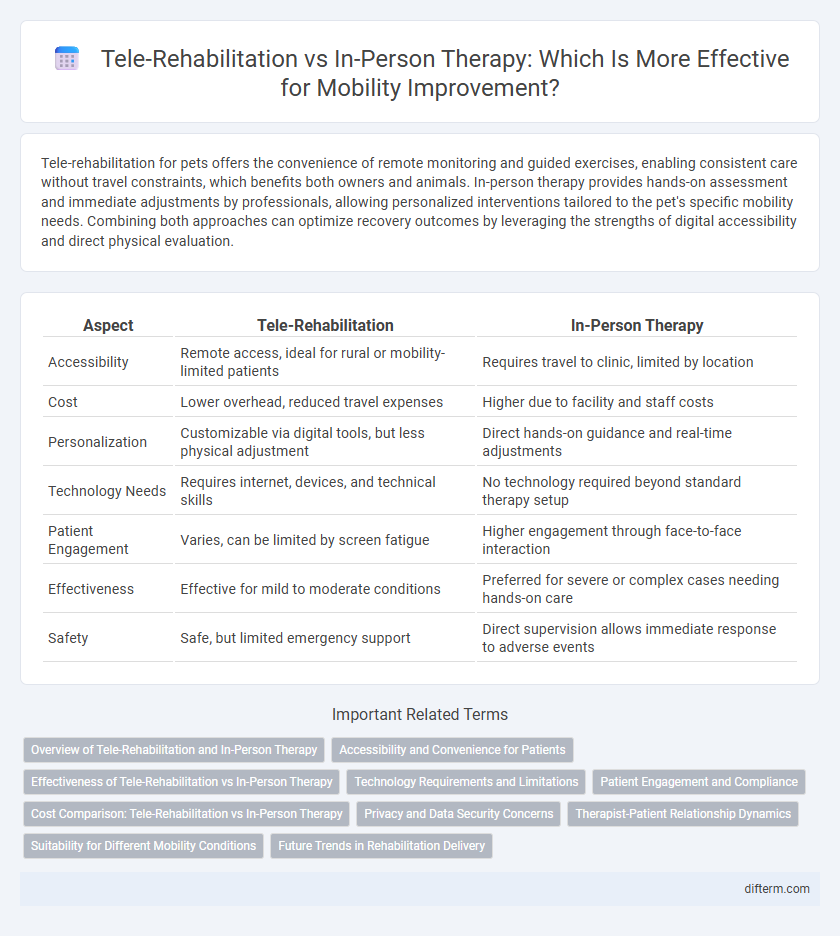Tele-rehabilitation for pets offers the convenience of remote monitoring and guided exercises, enabling consistent care without travel constraints, which benefits both owners and animals. In-person therapy provides hands-on assessment and immediate adjustments by professionals, allowing personalized interventions tailored to the pet's specific mobility needs. Combining both approaches can optimize recovery outcomes by leveraging the strengths of digital accessibility and direct physical evaluation.
Table of Comparison
| Aspect | Tele-Rehabilitation | In-Person Therapy |
|---|---|---|
| Accessibility | Remote access, ideal for rural or mobility-limited patients | Requires travel to clinic, limited by location |
| Cost | Lower overhead, reduced travel expenses | Higher due to facility and staff costs |
| Personalization | Customizable via digital tools, but less physical adjustment | Direct hands-on guidance and real-time adjustments |
| Technology Needs | Requires internet, devices, and technical skills | No technology required beyond standard therapy setup |
| Patient Engagement | Varies, can be limited by screen fatigue | Higher engagement through face-to-face interaction |
| Effectiveness | Effective for mild to moderate conditions | Preferred for severe or complex cases needing hands-on care |
| Safety | Safe, but limited emergency support | Direct supervision allows immediate response to adverse events |
Overview of Tele-Rehabilitation and In-Person Therapy
Tele-rehabilitation leverages digital platforms to deliver therapeutic exercises and assessments, enabling remote access for patients with mobility challenges. In-person therapy provides hands-on interventions and real-time feedback, fostering direct clinician-patient interaction crucial for complex motor skills development. Both approaches aim to improve functional outcomes, with tele-rehabilitation offering flexibility and scalability, while in-person therapy remains essential for individualized treatment and immediate corrective guidance.
Accessibility and Convenience for Patients
Tele-rehabilitation significantly enhances accessibility by eliminating geographical barriers, allowing patients in remote or underserved areas to receive specialized care without the need for travel. The convenience of scheduling sessions from home reduces time and financial burdens associated with transportation and waiting rooms. In-person therapy offers hands-on assistance and immediate physical adjustments but often requires patients to adhere to strict appointment times and commute challenges.
Effectiveness of Tele-Rehabilitation vs In-Person Therapy
Tele-rehabilitation demonstrates comparable effectiveness to in-person therapy in improving mobility outcomes for patients with musculoskeletal and neurological conditions. Studies report similar rates of functional improvement, pain reduction, and patient satisfaction between tele-rehabilitation and conventional face-to-face therapy sessions. The integration of remote monitoring tools enhances personalized care, making tele-rehabilitation a viable alternative for ongoing rehabilitation needs.
Technology Requirements and Limitations
Tele-rehabilitation requires reliable high-speed internet, compatible devices such as smartphones or tablets, and secure video conferencing platforms to ensure effective remote therapy sessions. Limitations include potential technical issues like connectivity disruptions, lack of tactile feedback, and challenges in conducting precise physical assessments compared to in-person therapy. In-person therapy benefits from direct physical interaction and hands-on techniques but depends on patients' ability to travel to clinical settings, limiting accessibility for those with mobility constraints.
Patient Engagement and Compliance
Tele-rehabilitation increases patient engagement by offering flexible scheduling and real-time feedback through digital platforms, which enhances compliance by enabling continuous monitoring and personalized adjustments. In-person therapy benefits from direct interpersonal interaction and hands-on guidance, fostering motivation and accountability that improve adherence to treatment plans. Combining tele-rehabilitation with traditional sessions can optimize patient compliance by leveraging both remote accessibility and physical therapist support.
Cost Comparison: Tele-Rehabilitation vs In-Person Therapy
Tele-rehabilitation offers a cost-effective alternative to in-person therapy by reducing expenses related to travel, facility use, and time off work. Studies show tele-rehabilitation can lower overall treatment costs by up to 50%, making it more accessible without compromising quality. Insurance providers increasingly recognize tele-rehabilitation as a reimbursable service, further enhancing its affordability compared to traditional therapy.
Privacy and Data Security Concerns
Tele-rehabilitation platforms must implement end-to-end encryption and secure authentication protocols to protect sensitive patient data, addressing growing privacy concerns. In-person therapy benefits from controlled clinical environments that limit data exposure but may still face risks related to physical record handling and unauthorized access. Ensuring compliance with HIPAA and GDPR standards is critical for both tele-rehabilitation and in-person therapy to maintain data security and patient trust.
Therapist-Patient Relationship Dynamics
Tele-rehabilitation enhances therapist-patient relationship dynamics by enabling continuous, real-time communication through digital platforms, fostering greater engagement and personalized care. In-person therapy offers direct physical interaction, which can improve hands-on assessments and nonverbal cue recognition critical for mobility progress. The combination of tele-rehabilitation's flexibility and in-person therapy's tactile feedback supports adaptive treatment plans that respond to patient needs efficiently.
Suitability for Different Mobility Conditions
Tele-rehabilitation offers flexible access for patients with mild to moderate mobility impairments, enabling consistent therapy through remote monitoring and guided exercises. In-person therapy is more suitable for severe mobility conditions requiring hands-on assistance, manual adjustments, and specialized equipment. Hybrid models combining both approaches optimize outcomes by tailoring intervention intensity and accessibility to individual patient needs.
Future Trends in Rehabilitation Delivery
Tele-rehabilitation leverages advanced digital platforms and wearable sensors to offer personalized, remote therapy sessions that enhance patient accessibility and monitoring. Emerging trends suggest the integration of artificial intelligence and virtual reality will further optimize rehabilitation outcomes by delivering immersive, data-driven treatments. These innovations are poised to transform traditional in-person therapy, enabling hybrid models that combine remote convenience with periodic direct clinical assessments.
tele-rehabilitation vs in-person therapy Infographic

 difterm.com
difterm.com